2014 PEUGEOT 3008 child seat
[x] Cancel search: child seatPage 133 of 389
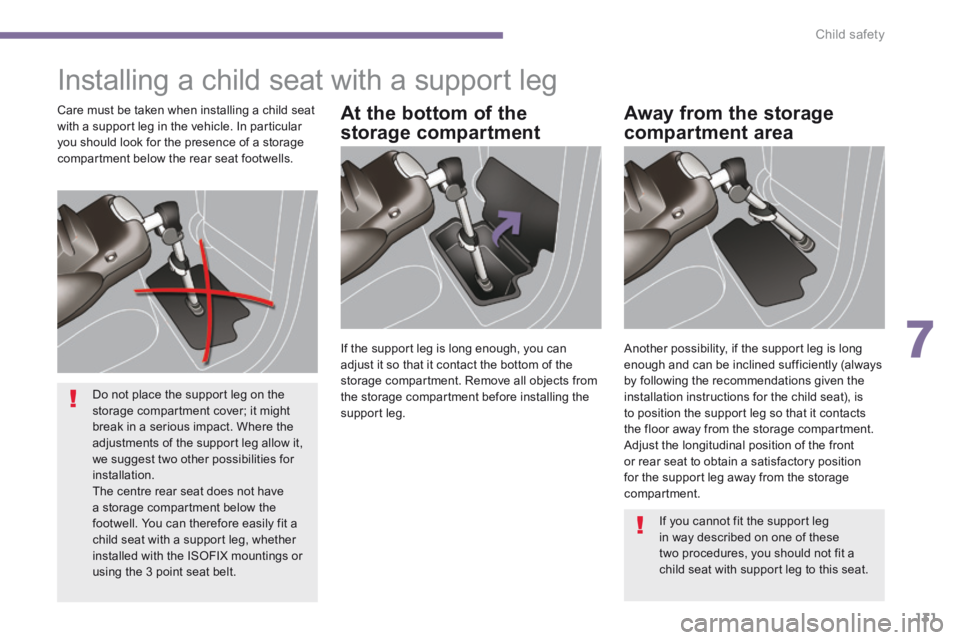
7
Child safety131
Installing a child seat with a support leg
At the bottom of the
storage compartment
Away from the storage
compartment area
Care must be taken when installing a child seat with a support leg in the vehicle. In particular you should look for the presence of a storage compartment below the rear seat footwells.
Do not place the support leg on the storage compartment cover; it might break in a serious impact. Where the
adjustments of the support leg allow it, we suggest two other possibilities for installation. The centre rear seat does not have a storage compartment below the footwell. You can therefore easily fit a child seat with a support leg, whether installed with the ISOFIX mountings or using the 3 point seat belt.
If you cannot fit the support leg in way described on one of these two procedures, you should not fit a child seat with support leg to this seat.
If the support leg is long enough, you can adjust it so that it contact the bottom of the storage compartment. Remove all objects from the storage compartment before installing the support leg.
Another possibility, if the support leg is long enough and can be inclined sufficiently (always by following the recommendations given the installation instructions for the child seat), is to position the support leg so that it contacts the floor away from the storage compartment. Adjust the longitudinal position of the front or rear seat to obtain a satisfactory position for the support leg away from the storage compartment.
Page 134 of 389

Child safety
132
Child seats recommended by PEUGEOT
Group 0+: from bir th to 13 kgGroup 1: from 9 to 18 kg
L1 "RÖMER /BRITA X Baby-Safe Plus". Installed in the rearward-facing position.
L2 "RÖMER Duo Plus ISOFIX".
Groups 2 and 3: from 15 to 36 kg
L5 "KLIPPAN Optima". From the age of approximately 6 years
(22 kg), the booster is used on its own.
L6 "RÖMER KIDFIX" Can be secured using the vehicle's ISOFIX mountings. The child is
restrained by the seat belt.
PEUGEOT offers a complete range of recommended child seats which are secured using a three point seat belt .
Page 135 of 389
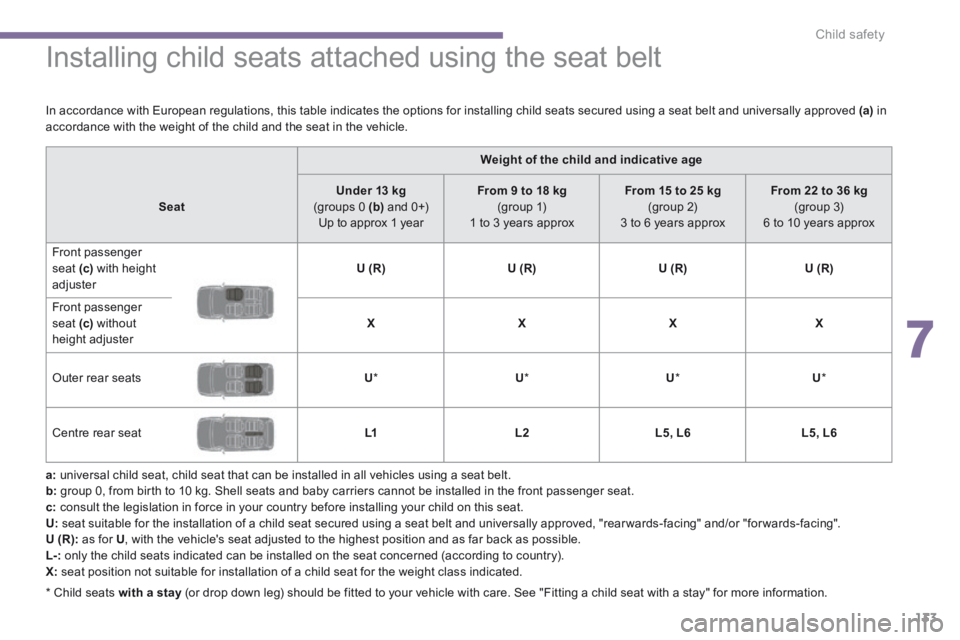
7
Child safety133
Installing child seats attached using the seat belt
a: universal child seat, child seat that can be installed in all vehicles using a seat belt. b: group 0, from birth to 10 kg. Shell seats and baby carriers cannot be installed in the front passenger seat. c: consult the legislation in force in your country before installing your child on this seat. U: seat suitable for the installation of a child seat secured using a seat belt and universally approved, "rear wards-facing" and/or "for wards-facing". U (R): as for U , with the vehicle's seat adjusted to the highest position and as far back as possible. L-: only the child seats indicated can be installed on the seat concerned (according to country). X: seat position not suitable for installation of a child seat for the weight class indicated.
In accordance with European regulations, this table indicates the options for installing child seats secured using a seat belt and universally approved (a) in accordance with the weight of the child and the seat in the vehicle.
* Child seats with a stay (or drop down leg) should be fitted to your vehicle with care. See "Fitting a child seat with a stay" for more information.
Weight of the child and indicative age
SeatUnder 13 kg (groups 0 (b) and 0+) Up to approx 1 year
From 9 to 18 kg (group 1) 1 to 3 years approx
From 15 to 25 kg (group 2) 3 to 6 years approx
From 22 to 36 kg (group 3) 6 to 10 years approx
Front passenger seat (c) with height adjuster U (R)U (R)U (R)U (R)
Front passenger seat (c) without height adjuster XXXX
Outer rear seats U * U * U * U *
Centre rear seat L1L2L5, L6L5, L6
Page 136 of 389

Child safety
134
"ISOFIX" mountings
The ISOFIX mountings are three rings for each seat: - two rings A , located between the vehicle seat back and cushion, indicated by a marking,
This ISOFIX mounting system ensures fast, reliable and safe fitting of the child seat in your vehicle.
The ISOFIX child seats are fitted with two
latches which are secured easily on the two rings A .
Some also have an upper strap (or top tether) which is attached to ring B .
To secure the child seat to the TOP TETHER : - remove and stow the head restraint before installing the child seat on this seat (refit it after the child seat has been removed), - remove the TOP TETHER cover by pulling at its cut-out, - pass the child seat strap behind the seat backrest, centred between the holes for the head restraint rods, - secure the upper strap fixing to the ring B , - tighten the upper strap.
Your vehicle has been approved in accordance with the latest ISOFIX regulations . The seats, represented below, are fitted with regulation ISOFIX mountings:
- a ring B , located under a cover on the back of
the top of the seat backrest, referred to as the TOP TETHER for fixing the upper strap. TOP TETHER for fixing the upper strap. TOP TETHER Its position is indicated by a marking.
For information on the possibilities for fitting ISOFIX child seats to your vehicle, refer to the table of seating positions.
The incorrect installation of a child seat in a vehicle compromises the child's
protection in the event of an accident. Observe strictly the fitting instructions provided with the child seat.
Located on the back of the seat backrest, the top tether is used to secure the upper strap of child seats that have one. This device limits
for ward tipping of the child seat, in the event of a front impact.
Page 137 of 389
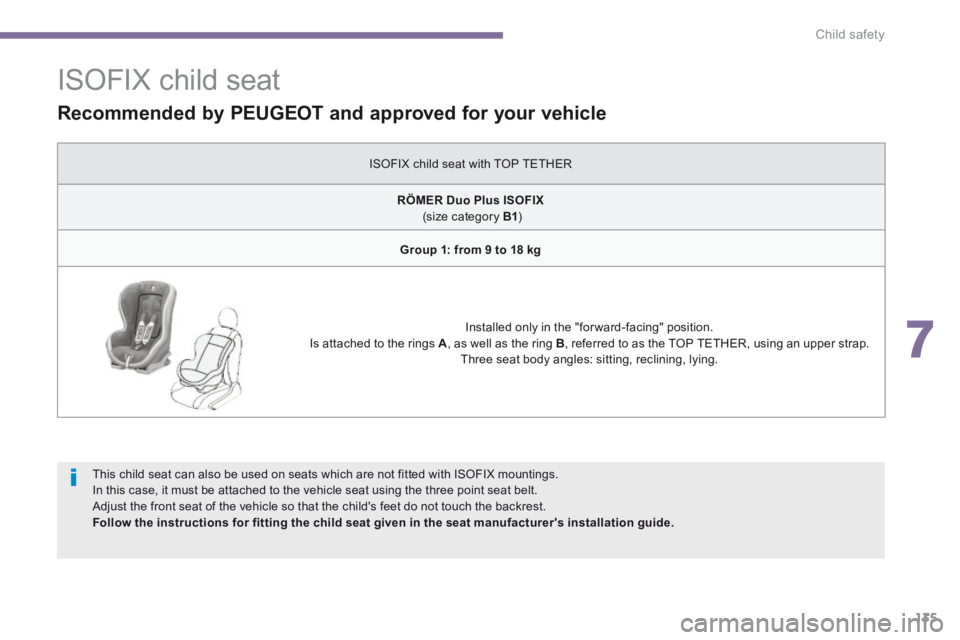
7
Child safety135
ISOFIX child seat
This child seat can also be used on seats which are not fitted with ISOFIX mountings. In this case, it must be attached to the vehicle seat using the three point seat belt. Adjust the front seat of the vehicle so that the child's feet do not touch the backrest. Follow the instructions for fitting the child seat given in the seat manufacturer's installation guide.
Recommended by PEUGEOT and approved for your vehicle
ISOFIX child seat with TOP TETHER
RÖMER Duo Plus ISOFIX (size category B1 )
Group 1: from 9 to 18 kg
Installed only in the "forward-facing" position. Is attached to the rings A , as well as the ring B , referred to as the TOP TETHER, using an upper strap. Three seat body angles: sitting, reclining, lying.
Page 138 of 389
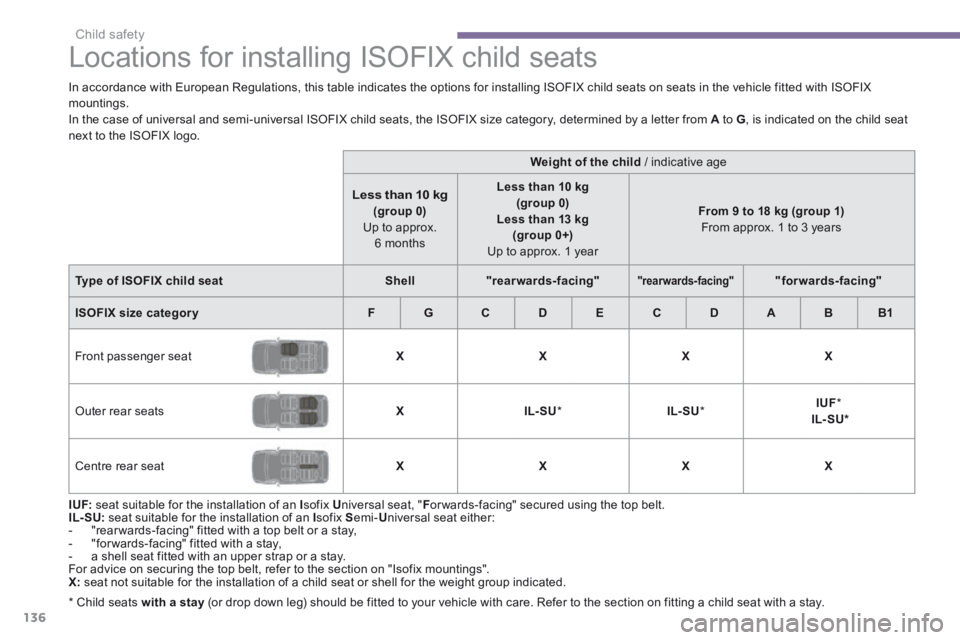
Child safety
136
Locations for installing ISOFIX child seats
I UF: seat suitable for the installation of an I sofix U niversal seat, " F or wards-facing" secured using the top belt. IL- SU: seat suitable for the installation of an I sofix S emi- U niversal seat either: - "rear wards-facing" fitted with a top belt or a stay, - "for wards-facing" fitted with a stay, - a shell seat fitted with an upper strap or a stay. For advice on securing the top belt, refer to the section on "Isofix mountings". X: seat not suitable for the installation of a child seat or shell for the weight group indicated.
In accordance with European Regulations, this table indicates the options for installing ISOFIX child seats on seats in the vehicle fitted with ISOFIX mountings. In the case of universal and semi-universal ISOFIX child seats, the ISOFIX size category, determined by a letter from A to G , is indicated on the child seat next to the ISOFIX logo.
* Child seats with a stay (or drop down leg) should be fitted to your vehicle with care. Refer to the section on fitting a child seat with a stay.
Weight of the child / indicative age
Less than 10 kg (group 0)
Up to approx. 6 months
Less than 10 kg (group 0) Less than 13 kg
(group 0+) Up to approx. 1 year
From 9 to 18 kg (group 1)
From approx. 1 to 3 years
Type of ISOFIX child seatShell"rearwards-facing""rearwards-facing" "forwards-facing"
ISOFIX size categor yFGCDECDABB1
Front passenger seat XXXX
Outer rear seats XIL- SU * IL- SU * IUF * IL- SU *
Centre rear seat XXXX
Page 139 of 389
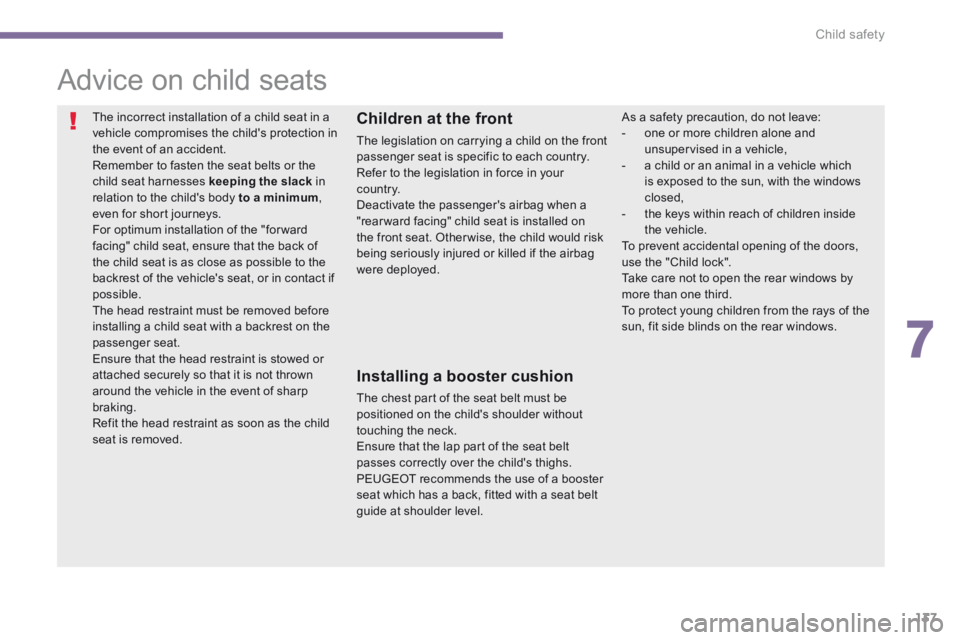
7
Child safety137
Advice on child seats
The incorrect installation of a child seat in a vehicle compromises the child's protection in the event of an accident. Remember to fasten the seat belts or the child seat harnesses keeping the slack in relation to the child's body to a minimum , even for short journeys. For optimum installation of the "forward facing" child seat, ensure that the back of the child seat is as close as possible to the backrest of the vehicle's seat, or in contact if possible . The head restraint must be removed before installing a child seat with a backrest on the passenger seat. Ensure that the head restraint is stowed or attached securely so that it is not thrown around the vehicle in the event of sharp braking. Refit the head restraint as soon as the child seat is removed.
Children at the front
The legislation on carrying a child on the front passenger seat is specific to each country. Refer to the legislation in force in your c o unt r y. Deactivate the passenger's airbag when a "rear ward facing" child seat is installed on the front seat. Otherwise, the child would risk being seriously injured or killed if the airbag were deployed.
Installing a booster cushion
The chest part of the seat belt must be positioned on the child's shoulder without touching the neck. Ensure that the lap part of the seat belt passes correctly over the child's thighs. PEUGEOT recommends the use of a booster seat which has a back, fitted with a seat belt guide at shoulder level.
As a safety precaution, do not leave: - one or more children alone and unsupervised in a vehicle, - a child or an animal in a vehicle which is exposed to the sun, with the windows closed, - the keys within reach of children inside the vehicle. To prevent accidental opening of the doors, use the "Child lock". Take care not to open the rear windows by more than one third. To protect young children from the rays of the sun, fit side blinds on the rear windows.
Page 151 of 389

8
Safety149
The driver must ensure that passengers use the seat belts correctly and that they are all restrained securely before setting off. Wherever you are seated in the vehicle, always fasten your seat belt, even for short journeys. Do not interchange the seat belt buckles as they will not fulfil their role fully. The seat belts are fitted with an inertia reel permitting automatic adjustment of the length of the strap to your size. The seat belt is stowed automatically when not in use. Before and after use, ensure that the seat belt is reeled in correctly. The lower part of the strap must be positioned as low as possible on the pelvis. The upper part must be positioned in the hollow of the shoulder. The inertia reels are fitted with an automatic locking device which comes into operation in the event of a collision, emergency braking or if the vehicle rolls over. You can release the device by pulling firmly on the strap and releasing it so that it reels in slightly.
In order to be effective, a seat belt must: - be tightened as close to the body as possible, - be pulled in front of you with a smooth movement, checking that it does not twist, - be used to restrain only one person, - not bear any trace of cuts or fraying, - not be converted or modified to avoid affecting its performance.
In the event of an impact
Depending on the nature and seriousness of the impact , the pretensioning device may be deployed before and independently of the airbags. Deployment of the pretensioners is accompanied by a slight discharge of harmless smoke and a noise, due to the activation of the pyrotechnic cartridge incorporated in the system. In all cases, the airbag warning lamp comes on. Following an impact, have the seat belts system checked, and if necessary replaced, by a PEUGEOT dealer or a qualified workshop.
Recommendations for children
Use a suitable child seat if the passenger is less than 12 years old or shorter than one and a half metres. Never use the same seat belt to secure more than one person. Never allow a child to travel on your lap.
In accordance with current safety regulations, for all repairs on your vehicle, go to a qualified workshop with the skills and equipment needed, which a PEUGEOT dealer is able to provide. Have your seat belts checked regularly by a PEUGEOT dealer or a qualified workshop, particularly if the straps show signs of damage.
Clean the seat belt straps with soapy water or a textile cleaning product, sold by PEUGEOT dealers. After folding or moving a seat or rear bench seat, ensure that the seat belt is positioned and reeled in correctly.